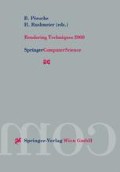Abstract
Increased application of computer graphics in areas which demand high levels of realism has made it necessary to examine the manner in which images are evaluated and validated. In this paper, we explore the need for including the human observer in any process which attempts to quantify the level of realism achieved by the rendering process, from measurement to display. We introduce a framework for measuring the perceptual equivalence (from a lightness perception point of view) between a real scene and a computer simulation of the same scene. Because this framework is based on psychophysical experiments, results are produced through study of vision from a human rather than a machine vision point of view. This framework can then be used to evaluate, validate and compare rendering techniques.
Access this chapter
Tax calculation will be finalised at checkout
Purchases are for personal use only
Preview
Unable to display preview. Download preview PDF.
References
E. H. Adelson, Lightness Perception and Lightness Illusions, 339–351, MIT Press, 1999, pp. 339–351.
J. Cataliotti and A. Gilchrist, Local and global processes in lightness perception, Perception and Psychophysics, vol. 57(2), 1995, pp. 125–135.
H. Coolican, Research methods and statistics in psychology, Hodder and Stoughton, Oxford, 1999.
S. Daly, The visible difference predictor: an algorithm for the assessment of ima ge fidelity, In A. B. Watson Editor, Digital Images and Human Vision, MIT Press, 1993, pp. 179–206.
J. A. Ferwerda, S.N. Pattanaik, P. Shirley, and D. P. Greenberg, A model of visual adaptation for realistic image synthesis, Computer Graphics 30 (1996), no. Annual Conference Series, 249–258.
J. Gervais, Jr. L.O. Harvey, and J.O. Roberts, Identification confusions among letters of the alphabet, Journal of Experimental Psychology: Human Perception and Perfor mance, vol. 10(5), 1984, pp. 655–666.
A. Gilchrist, Lightness contrast and filures of lightness constancy: a common explanation, Perception and Psychophysics, vol. 43(5), 1988, pp. 125–135.
A. Gilchrist, S. Delman, and A. Jacobsen, The classification and integration of edges as critical to the perception of reflectance and illumination, Perception and Psychophysics 33 (1983), no. 5, 425–436.
A. Gilchrist and A. Jacobsen, Perception of lightness and illumination in a world of one reflectance, Perception 13 (1984), 5–19.
A. L. Gilchrist, The perception of surface blacks and whites, Scientific American 240 (1979), no. 3, 88–97.
J. L. Mannos and D. J. Sakrison, The effects of a visual criterion on the encoding of images, IEEE Transactions on Information Theory IT-20 (1974), no. 4, 525–536.
A. McNamara, A. Chalmers, T. Troscianko, and E. Reinhard, Fidelity of graphics reconstructions: A psychophysical investigation, Proceedings of the 9th Eurographics Rendering Workshop, Springer Verlag, June 1998, pp. 237–246.
G. W. Meyer, H. E. Rushmeier, M. E Cohen, D. P. Greenberg, and K. E. Torrance, An Experimental Evaluation of Computer Graphics Imagery, ACM Transactions on Graphics 5 (1986), no. 1, 30–50.
K. Myszkowski, The visible differences predictor: Applications to global illumination problems, Rendering Techniques ‘98 (Proceedings of Eurographics Rendering Workshop ‘98) (New York, NY) (G. Drettakis and N. Max, eds.), Springer Wien, 1998, pp. 233–236.
H. Rushmeier, G. Ward, C. Piatko, P. Sanders, and B. Rust, Comparing real and synthetic images: Some ideas about metrics, Eurographics Rendering Workshop 1995, Eurographics, June 1995.
D. Travis, Effective color displays, Academic Press, 1991.
G. J. Ward, The RADIANCE lighting simulation and rendering system, Proceedings of SIG-GRAPH ‘94 (Orlando, Florida, July 24–29, 1994) (Andrew Glassner, ed.), Computer Graphics Proceedings, Annual Conference Series, ACM SIGGRAPH, ACM Press, July 1994, ISBN 0–89791–667–0, pp. 459–472.
Author information
Authors and Affiliations
Editor information
Editors and Affiliations
Rights and permissions
Copyright information
© 2000 Springer-Verlag Wien
About this paper
Cite this paper
McNamara, A., Chalmers, A., Troscianko, T., Gilchrist, I. (2000). Comparing Real & Synthetic Scenes using Human Judgements of Lightness. In: Péroche, B., Rushmeier, H. (eds) Rendering Techniques 2000. EGSR 2000. Eurographics. Springer, Vienna. https://doi.org/10.1007/978-3-7091-6303-0_19
Download citation
DOI: https://doi.org/10.1007/978-3-7091-6303-0_19
Published:
Publisher Name: Springer, Vienna
Print ISBN: 978-3-211-83535-7
Online ISBN: 978-3-7091-6303-0
eBook Packages: Springer Book Archive

